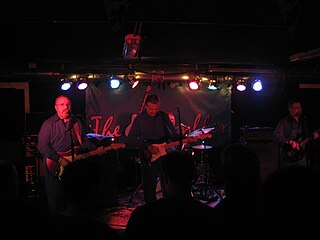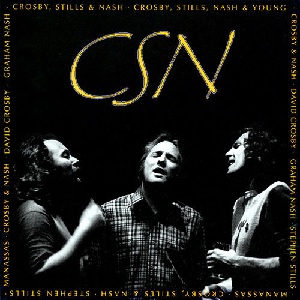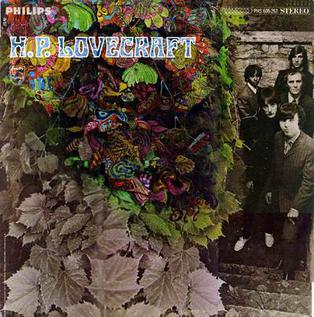
Blood, Sweat & Tears is an American jazz rock music group founded in New York City in 1967, noted for a combination of brass with rock instrumentation. BS&T has gone through numerous iterations with varying personnel and has encompassed a wide range of musical styles. Their sound has merged rock, pop and R&B/soul music with big band jazz.

The Shadows of Knight were an American rock band from Chicago, Illinois, that played a version of British blues influenced by their native city. When they began recording in 1965, the band's self-description was "the Stones, Animals and the Yardbirds took the Chicago blues and gave it an English interpretation. We've taken the English version of the Blues and re-added a Chicago touch," to which rock critic Richie Unterberger commented: "The Shadows of Knight's self-description was fairly accurate."

The Trashmen were an American rock band formed in Minneapolis in 1962 and are best known for their biggest hit, 1963's "Surfin' Bird", which reached No. 4 on the Billboard Hot 100. The original line-up of the group featured guitarists Tony Andreason and Dal Winslow, bassist Bob Reed, and drummer Steve Wahrer.
Dunwich Records was an independent American record label started by Bill Traut, Eddie Higgins and George Badonsky in Chicago in 1965. Dunwich was also a production company which licensed recordings to other labels, including Atlantic, Atco, Columbia, Mercury and SGC. The label was primarily known for the release of singles from the emerging Chicago rock scene in the 1960s. Only two artists, the Shadows of Knight and Amanda Ambrose, released albums on the label.

H. P. Lovecraft was an American psychedelic rock band, formed in Chicago in 1967 and named after the horror writer H. P. Lovecraft. Much of the band's music was inspired by the writings of the author whose name they had adopted and combining elements of psychedelia and folk rock.
"I've Been Waiting for You" is a song written by Neil Young, which he recorded for his 1968 debut solo album. In a song review for AllMusic, critic Matthew Greenwald described it as "One of the most powerful and well-crafted songs from Neil Young's self-titled solo debut ... A very strong and engaging melody is set against a striking, descending guitar riff, which serves as the song's hook."
Charles Ethan Kenning is an American singer, songwriter and musician who performed as George Edwards when he led 1960s acid rock band, H. P. Lovecraft. He was adopted as a child and brought up under the name George Edwards. He reverted to his birth name of Ethan Kenning in his mid-30s.
Jerry McGeorge came to prominence in late 1965 as an American guitarist with the Chicago rock band The Shadows of Knight. He later joined the psychedelic rock band H.P. Lovecraft on bass in the summer of 1967, appearing on their debut album, H. P. Lovecraft.

East-West is the second album by the American blues rock band the Butterfield Blues Band, released in 1966 on the Elektra label. It peaked at No. 65 on the Billboard pop albums chart, and is regarded as highly influential by rock and blues music historians.

CSN is a box set by Crosby, Stills & Nash, issued on Atlantic Records in 1991. It features material spanning from 1968 through 1990 from their catalogue of recordings as a group in addition to selections from Crosby & Nash, Manassas, and their individual solo albums. It peaked at No. 109 on the Billboard 200, and has been certified platinum by the RIAA. The set is "dedicated to the loving memory of Cass Elliot, without whom most of this music may not have been made." A two-disc distillation of the box was released for other markets later in the year.
The Human Instinct are a New Zealand rock band that has been active since the late 1960s. The band currently consists of Maurice Greer, Phil Pritchard (guitar), Joel Haines (guitar) and Tony Baird (bass). The band has had more than 25 members and has changed lineups several times since its formation under the leadership of Maurice Greer.
Rhinoceros was an American rock band established in 1967 through auditions conducted by Elektra Records, rather than organic formation by musicians. The band, while well respected in many circles, did not live up to the record label's expectations. It was also poorly received by fans, producing a slow-selling debut album and two even less successful LPs before breaking up. One reviewer commented, "Despite the fact that the band could not live up to the expectations that were raised by Elektra Records' publicity machine, Rhinoceros' contributions to rock still deserve more credit than subsequent rock histories give it."
Kokomo are a British band whose members were prime exponents of British soul in the 1970s. They released three albums, and the second Rise & Shine was described as "the finest British funk album of the 1970s".

The Bushwackers Band, often simply the Bushwackers, are an Australian folk and country music band or bush band founded in 1970. Their cover version of "And the Band Played Waltzing Matilda" (1976) was listed in the APRA Top 30 Australian songs in 2001, alongside its writer Eric Bogle's 1980 rendition. Their top 60 studio albums on the Australian Kent Music Report are Bushfire (1978), Dance Album (1980), Faces in the Street and Beneath the Southern Cross.
The Badloves are an Australian R&B, soul band that formed as DC3 in 1990 by founding mainstay member Michael Spiby on guitar and lead vocals. They changed their name after a year. Their debut studio album, Get on Board, was issued in July 1993, which peaked at No. 5 on the ARIA Albums Chart. At the ARIA Music Awards of 1994 they won Best New Talent and Breakthrough Artist – Album for Get on Board and Breakthrough Artist – Single for its first single, "Lost" (1993). The Badloves' second album, Holy Roadside, reached the top 20. Their highest-charting single, "The Weight" (1993), is a cover version of the Band's 1968 single and features Jimmy Barnes on co-lead vocals. It reached the ARIA singles chart top 10.
The Crusaders was an American garage rock band, whose 1966 album Make a Joyful Noise with Drums and Guitars is considered one of the first gospel rock releases, or even "the first record of Christian rock".

H. P. Lovecraft is the debut album by the American psychedelic rock band H. P. Lovecraft. It was released in October 1967 by Philips Records.

H. P. Lovecraft II is the second album by the American psychedelic rock band H. P. Lovecraft and was released in September 1968 on Philips Records. As with their debut LP, the album saw the band blending psychedelic and folk rock influences, albeit with a greater emphasis on psychedelia than on their first album. H. P. Lovecraft II failed to sell in sufficient quantities to reach the Billboard Top LPs chart or the UK Albums Chart, despite the band being a popular act on the U.S. psychedelic concert circuit. Legend has it that the album was the first major label release to have been recorded by musicians who were all under the influence of LSD.
"The Loner" is a song by Neil Young, his first solo single. It was released on his solo debut album in November 1968, and then an edited version as his debut solo single three months later on Reprise Records. It missed the Billboard Hot 100 chart completely, but over time has become a staple of his performance repertoire. Both it and "Sugar Mountain", its B-side recorded live at the Canterbury House in Ann Arbor, Michigan, were released on album together for his 1977 compilation, Decade.
"The White Ship" is a song released by the American psychedelic rock band, H. P. Lovecraft, in November 1967. The songwriting is credited to band members George Edwards, Dave Michaels, and Tony Cavallari. Acting as the opening song on the second side of their debut LP, H. P. Lovecraft, it was the album's longest track, and an edited version was also released as the band's second single. The name and theme of the song derive directly from author H. P. Lovecraft's short story, "The White Ship". Despite its failure to chart nationally, it is widely considered to be H. P. Lovecraft's most accomplished piece, and helped establish the group, who were originally from Chicago, in the West Coast music scene.









